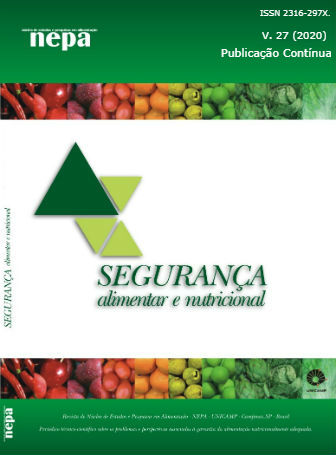Resumen
A questionnaire was conducted in the field with the cadets of the Brazilian Air Force Academy, and its main objective was to verify their perception of the food provided by the military organization, in order to understand which kinds of food were considered positive and negative foods for wellbeing and their daily physical performance, and how the food supplied affects their routine in any aspect. The research was carried out with 130 participants, through a questionnaire of unstructured qualitative analysis and word association technique. Participants were approached shortly after lunch, inside the mess hall. The results showed that the majority of cadets classified as positive or negative foods in terms of taste and not for their nutritional value. The cadets have also correlated food to physical and mental wellbeing and affirmed that a good meal directly affects their routine.
Citas
Ryan RM, Deci EL. On Happiness and Human Potentials: A Review of Research on Hedonic and Eudaimonic Well-Being. Annual Review of Psychology. 2001;3:141-166.
Zhang S, Yang H, Singh L. Measuring quality of life: Economic, social, and subjective indicators. Social Indicators Research. 1997;40:189-216.
Randler C, Desch IH, Otte im Kampe V, Wüst-Ackermann P, Wilde M, Prokop P. Anxiety, disgust and negative emotions influence food intake in humans. International Journal of Gastronomy and Food Science. 2017;7:11-15.
Mann J, Truswell AS. Essentials of human nutrition. United Kingdom: Oxford University Press; 2017.
Brasil & Força Aérea Brasileira. Norma Padrão de Ação: Rotina e Formaturas do Corpo de Cadetes da Aeronáutica. Portaria AFA no 244 de 27 de novembro de 2018.
Ares G, de Saldamando L, Giménez A, Claret A, Cunha LM, Guerrero L, de Moura AP, Oliveira DCR, Symoneaux R, Deliza R. Consumers’ associations with wellbeing in a food-related context: A cross-cultural study. Food Quality and Preference. 2015;40:304-315.
Ares G, Deliza R. Identifying important package features of milk desserts using free listing and word association. Food Quality and Preference. 2010;21(6):621-628.
Rocha YJP, Lapa-Guimarães J, de Noronha RLF, Trindade MA. Evaluation of consumers' perception regarding frankfurter sausages with different healthiness attributes. Journal of Sensory Studies. 2018;33(6):1-14.
Santos EL, Garcia PHM, Soares EC, Machado SS, Silva JM, Oliveira WDS. Perfil do consumo de peixes na cidade de Maceió, Alagoas. Revista Científica de Produção Animal. 2016;18(1):45-54.
Souza AM, Pereira RA, Yokoo EM, Levy RB, Shichieri R. Alimentos mais consumidos no Brasil: Inquérito Nacional de Alimentação 2008-2009. Revista de Saúde Pública. 2013;47(1):190-199.
Sonoda DY, Shirota R. Consumo de pescado no Brasil fica abaixo da média internacional. Visão agrícola. 2012; 8(11):145-147.
Sartori AG de O, Amancio RD. Fish: nutritional relevance and consumption in Brazil. Segurança Alimentar e Nutricional. 2015;19(2):83-93.
Scherr C, Gagliardi ACM, Miname MH, Santos RD. Concentração de Ácidos Graxos e Colesterol de Peixes Habitualmente Consumidos no Brasil. Arquivos Brasileiros de Cardiologia. 2015;104(2):152-158.
Simopoulos AP. Omega-6/Omega-3 Essential Fatty Acid Ratio and Chronic Diseases. Food Reviews International. 2004;20(1):77-90.
Ares G, Gámbaro A. Influence of gender, age and motives underlying food choice on perceived healthiness and willingness to try functional foods. Appetite. 2007;49(1):148-158.
Ares G, Giménez A, Gámbaro A. Understanding consumers’ perception of conventional and functional yogurts using word association and hard laddering. Food Quality Preference. 2008;19(7):636-643.
Van Wezemael L, Caputo V, Nayga RM, Chryssochoidis G, Verbeke W. European consumer preferences for beef with nutrition and health claims: A multi-country investigation using discrete choice experiments. Food Policy. 2014;44:167-176.
Rosendal L, Langberg H, Skov-Jensen A, Kjaer M. Incidence of injury and physical performance adaptations during military training. Clinical Journal of Sport Medicine. 2003;13(3):157-163.
Arkin W, Dobrofsky LR. Military Socialization and Masculinity. Journal of Social Issues. 1978;34(1):151-168.
Delahaij R, Dam KV. Coping with acute stress in the military: The influence of coping style, coping self-efficacy and appraisal emotions. Personality and Individual Differences. 2017;119:13-18.
Tondrá F. Handbook meat processing. USA: Wiley-Blackwell Editor; 2010.
Santos AS, Ribeiro DMA, Morais PMO. Avaliação qualitativa do cardápio de uma unidade de alimentação e nutrição de área militar em Belém-PA. In: Resumos do III Congresso de Educação em Saúde da Amazônia; 2014 12 14 novembro; Pará, Belém: COESA; 2014.
Bueno VF, Bergamasco NHP. Efeito da associação de sabor e música sobre o estado de ânimo de crianças. Estudos de Psicologia. 2008;25(3):385-393.
A revista Segurança Alimentar e Nutricional utiliza a licença do Creative Commons (CC), preservando assim, a integridade dos artigos em ambiente de acesso aberto.


